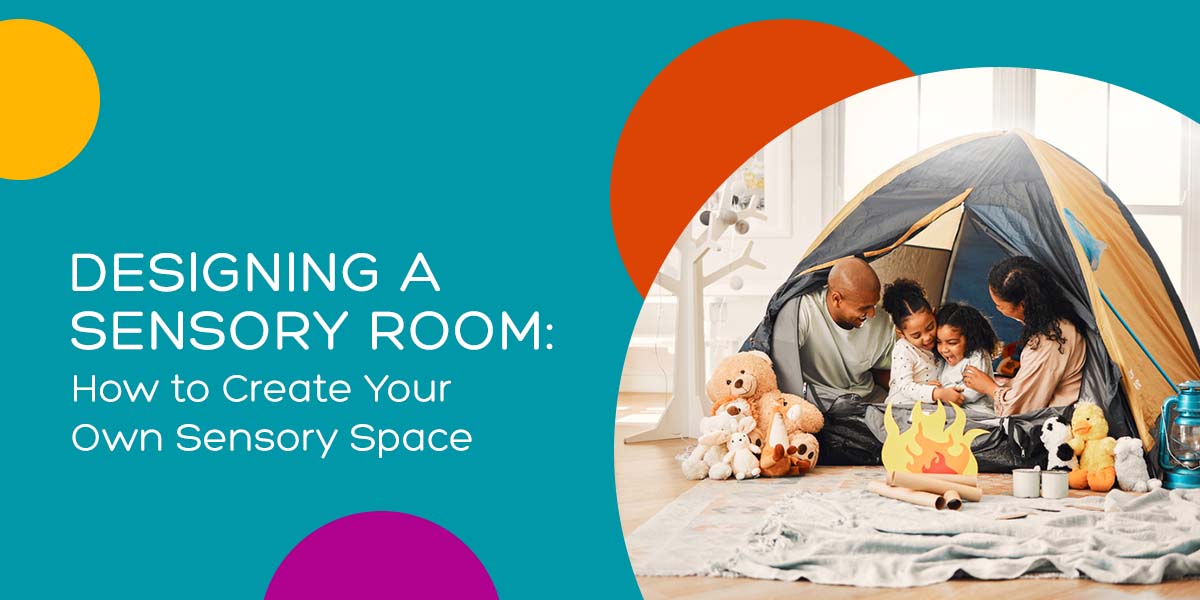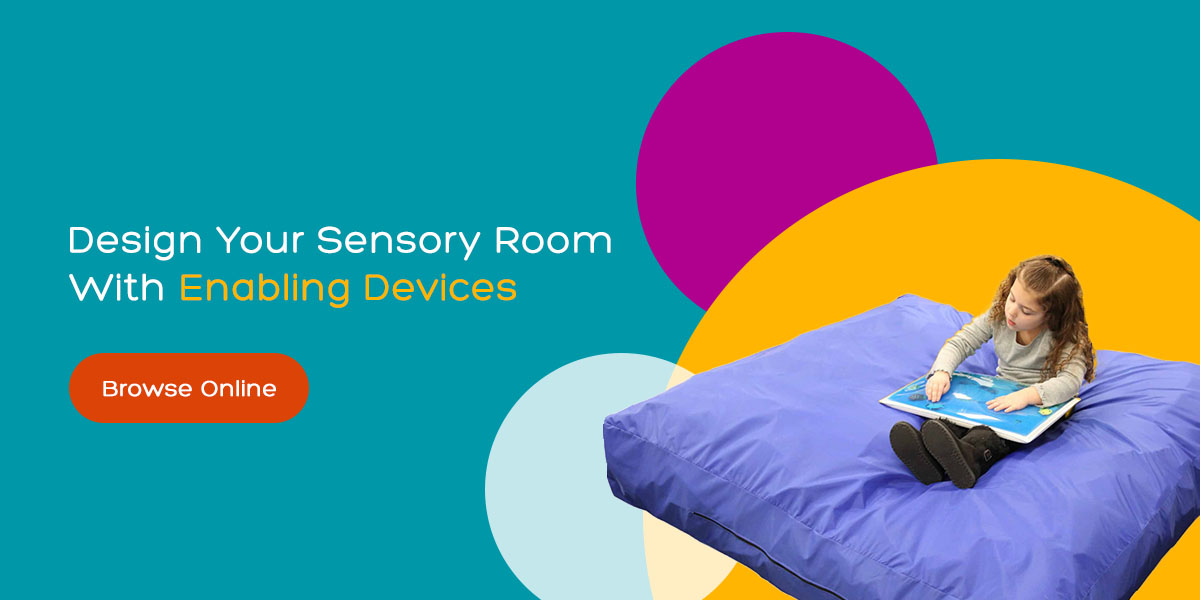Designing a Sensory Room: How to Create Your Own Sensory Space
Research and education have increased awareness of sensory needs among people with disabilities. Sensory rooms have emerged as an effective way to help people with sensory needs regulate or decompress. Parents, teachers and therapists can help both children and adults by creating a sensory room with multi-sensory experiences, stimulating any of the eight senses for therapeutic benefit.
What Is a Sensory Room?
A sensory room is an environment with sensory input devices where individuals can seek a sensory experience. Also called sensory spaces, these rooms have devices, equipment and toys to regulate, decompress or expel energy, depending on the user’s needs.
Since each person has different sensory needs, sensory rooms are designed to provide a tailored experience. The amount and intensity of sensory equipment can be changed to either calm or stimulate as needed, so the user does not become overstimulated or understimulated.
Sensory rooms are appropriate for all actual and development ages and can benefit anyone. Certain triggers can cause people with sensory needs to have a sensory overload or meltdown. A sensory space eliminates these triggers and provides soothing sensory input, so the user can regulate and feel calm.
Sensory spaces are most beneficial for individuals with:
- Sensory Processing Disorders (SPD): For people with SPD, sensory rooms are a controlled environment for sensory regulation and integration.
- Autism Spectrum Disorder (ASD): Sensory rooms are a common component of ASD therapy. Children and adults with ASD use sensory rooms to manage sensory sensitivities, regulate sensory experiences and develop life skills, like communication.
- Anxiety or stress: People experiencing stress, anxiety or sensory overload can use these rooms to relax and improve their emotional state.
- Developmental delays: Users with developmental delays can improve sensory processing skills, communication abilities, and fine and gross motor skills while in a sensory room.
How Sensory Rooms Help People With Sensory Needs
Sensory rooms provide the sensory input that the user needs. “Sensory” doesn’t necessarily mean “calm” — these spaces can soothe or acclimate the user to sounds, lights, vibrations and textures. A sensory room can be used to:
- Teach cause and effect: Children and adults can interact with sensory equipment and observe the consequences of their actions. Users can learn about cause and effect as they understand how their actions trigger a response.
- Provide an opportunity to explore freely: A sensory space allows users to explore their environment, work on sensory integration, self-regulate and more.
- Increase concentration and focus: Using a sensory room can help individuals with sensory needs improve their attention and focus.
- Heighten environmental awareness: Sensory spaces bring the user’s sensory system into equilibrium, making it easier to be aware of their surroundings.
- Promote cognitive development: Sensory equipment motivates users to learn and grow as they explore sensory inputs.
- Decrease aggressive behaviors: Sensory therapy is effective for managing stress and aggression. These safe spaces allow children and adults to play and explore without exposure to sensory triggers.
- Provide a sense of security and calmness: Devices with soothing sensory input can help users self-regulate or co-regulate when they feel overstimulated.
- Encourage vocalization and communication: A sensory room can be used as a speech therapy tool, helping users improve their communication skills.
- Improve eye-hand coordination and sensory-motor skills: Sensory spaces promote physical abilities to make users aware of their body position and movement and use this sensory input to complete actions like pressing a button or grabbing a toy.
- Promote social interactions: Sensory rooms provide opportunities for users to interact and develop social skills.
- Provide mental and physical relaxation: A sensory meltdown puts a person in fight-or-flight mode. The calming effect of a sensory room allows the nervous system to recover.
Watch this video to learn more about how a sensory space can help children and adults with disabilities:
Who Should Have a Sensory Room?
Locations where there is a high amount of stimuli should have a sensory room, such as:
- Homes
- Schools
- Public venues
- Sports arenas
- Community centers
- Hospitals and clinics
- Nursing homes
- Shopping malls
- Airports
Sensory rooms are becoming more common in professional sports stadiums. The loud noises, bright lights, crowds and other stimuli at these events can lead to sensory overload. Sensory rooms in stadiums allow sports fans to have a space to self-regulate.
Types of Sensory Rooms
Sensory rooms fall into three main categories:
Active
Active sensory spaces are designed for users seeking a sensory experience because they need more stimulation. Sensory activities provide vestibular and proprioceptive input to help regulate the nervous system, improve sensory-motor skills, enhance focus and develop body awareness. An active sensory space has tactile sensory toys and plenty of soft play mats to cushion movements.
Calming
Calming sensory rooms are designed for users who feel overstimulated and need a sensory break. The activities in this space allow individuals to decompress, relax and calm down. Sensory room ideas for a calming experience include sensory tubes, weighted products and fiber optic lighting.
Hybrid
Hybrid sensory spaces mix active and calming inputs to offer something for any sensory need. Users can use the active or calming sensory equipment based on what they need at the moment. Individuals can also use both areas, starting with active sensory experiences and transitioning to calm sensory inputs.
How to Design a Sensory Room
When planning a sensory space, consider:
- The needs of the individuals who will use the space: A sensory room should be tailored to each person’s unique needs — try different sensory equipment to find what works best.
- How much space is available: While they’re called sensory rooms, you don’t need an entire room if space is limited. For example, you can set up a sensory tent, and the user will receive the same benefits regardless of space.
- The type of sensory room: The purpose of the sensory space — whether more calming, more stimulating or both — will determine the equipment you need.
Designing a sensory room comes with many considerations, including factors like space constraints and budget. Enabling Devices can help you plan a sensory space for your home, school or office and find the right toys and devices for your users.
Why Trust Enabling Devices for Sensory Room Ideas?
Enabling Devices creates assistive devices that allow people with disabilities to fully participate in the world. Since our company was founded in 1978, we have been passionate about working with the disabilities community. We go beyond providing sensory equipment by offering support and resources for joyful and fulfilling lives.
Our team can help parents, teachers and therapists find the right sensory devices for their child, student or family member. If our vast selection of sensory products doesn’t include what you’re looking for, we can create a custom product to meet your unique requirements. We will take the time to learn more about the purpose of your sensory room and your users in order to connect you with the right devices.
Watch this video to see how we developed, designed and installed a sensory room for Cerebral Palsy of Westchester:
Design Your Sensory Room With Enabling Devices
Whether you are looking for sensory room ideas or a partner to handle your project, Enabling Devices can help. We offer:
- Quotes: Get a free online quote for sensory equipment. The quote is guaranteed for 90 days, and it’s easy to convert your quote into an online order.
- Design services: We offer free design services to help educators and therapists create their own sensory room. Complete our design questionnaire to get started.
- Fundraising ideas: If you need to fundraise for your sensory space, we have ideas so you can get the resources you need. Read our fundraising ideas brochure for more information.
Start designing your sensory room today. Explore our free resources or contact Enabling Devices to learn more.
Linked Sources:
- https://sensoryhealth.org/basic/your-8-senses
- https://enablingdevices.com/product-category/sensory/tactile/
- https://enablingdevices.com/product-category/sensory/cushionssoft-play/
- https://enablingdevices.com/product-category/sensory/sensory-tubes/
- https://enablingdevices.com/product-category/sensory/weighted-products/
- https://enablingdevices.com/product-category/sensory/fiber-optics/
- https://enablingdevices.com/product-category/sensory/kits-bundles/
- https://enablingdevices.com/product-category/sensory/
- https://enablingdevices.com/about-quotes/




